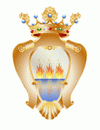Province of Foggia (Provincia di Foggia)
 |
This province is also known as Daunia, after the Daunians, an Iapygian pre-Roman tribe living in Tavoliere plain, and as Capitanata, derived from Catapanata, since the area was governed by a catepan as part of the Catepanate of Italy during the High Middle Ages. Its capital is the city of Foggia.
The province of Foggia can be divided in three parts: one centered on its capital called Tavoliere, another along the Apennines named Daunian Mountains and the third on the spur of the boot-shaped Italian peninsula called Gargano.
The Tavoliere is an important agricultural area: grapefruit, olives, durum wheat and tomato are the chief products. It is called "the granary of Italy" because of its significant wheat production.
Daunian Mountains lie along the border with Molise and Campania. Scattered with small villages, the mountains are covered by forests and pastures, with the main produce being hams and caciocavallo cheese. Faetar, a language descended from Franco-Provençal, is spoken in two villages: Faeto and Celle di San Vito.
The Gargano peninsula is partially mountainous and partially forested, Foresta Umbra with vegetation typical of Central Europe, the only part of the ancient Black Forest remaining in Italy. Allegedly its name comes from the word ombra (shadow) because of its density that prevents light from entering. The coast of Gargano has many beaches and tourist facilities. In the north are two major salt lakes Lesina and Varano. It produces olives, olive oil and typical mountain and seafood items.
Map - Province of Foggia (Provincia di Foggia)
Map
Country - Italy
 |
 |
| Flag of Italy | |
Italy was the native place of many civilizations such as the Italic peoples and the Etruscans, while due to its central geographic location in Southern Europe and the Mediterranean, the country has also historically been home to myriad peoples and cultures, who immigrated to the peninsula throughout history. The Latins, native of central Italy, formed the Roman Kingdom in the 8th century BC, which eventually became a republic with a government of the Senate and the People. The Roman Republic initially conquered and assimilated its neighbours on the Italian peninsula, eventually expanding and conquering a large part of Europe, North Africa and Western Asia. By the first century BC, the Roman Empire emerged as the dominant power in the Mediterranean Basin and became a leading cultural, political and religious centre, inaugurating the Pax Romana, a period of more than 200 years during which Italy's law, technology, economy, art, and literature developed.
Currency / Language
| ISO | Currency | Symbol | Significant figures |
|---|---|---|---|
| EUR | Euro | € | 2 |
| ISO | Language |
|---|---|
| CA | Catalan language |
| CO | Corsican language |
| FR | French language |
| DE | German language |
| IT | Italian language |
| SC | Sardinian language |
| SL | Slovene language |


































